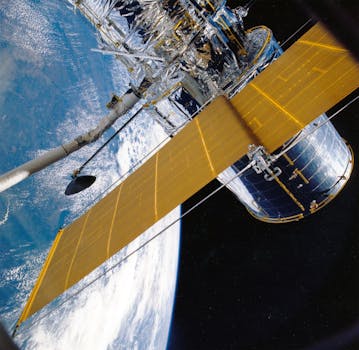GEO Satellites: Understanding the Technology and Applications of Geostationary Orbit Satellites
GEO satellites, or geostationary orbit satellites, play a crucial role in modern telecommunications, navigation, and weather forecasting. This article delves into the technology and applications of GEO satellites, exploring their history, functionality, and impact on various industries.

GEO Satellites: Introduction to Geostationary Orbit Satellites
GEO satellites, or geostationary orbit satellites, are a type of satellite that orbits the Earth at an altitude of approximately 36,000 kilometers above the equator. At this height, the satellite’s orbital period matches the Earth’s rotational period, allowing it to remain stationary relative to a fixed point on the planet’s surface. This unique characteristic enables GEO satellites to provide continuous coverage of a specific region, making them ideal for various applications such as telecommunications, navigation, and weather forecasting.
The concept of GEO satellites was first proposed by science fiction writer Arthur C. Clarke in 1945. However, it wasn’t until the launch of the first geostationary satellite, Syncom 2, in 1963 that the technology began to take shape. Since then, numerous GEO satellites have been launched, with many more planned for the future. Today, GEO satellites play a vital role in modern telecommunications, providing services such as television broadcasting, internet connectivity, and mobile communications.
How GEO Satellites Work
GEO satellites work by transmitting and receiving signals to and from Earth-based stations. The satellite’s antenna receives signals from the Earth station, amplifies them, and then retransmits them back to Earth, allowing the signal to be received by other Earth stations. This process is made possible by the satellite’s transponder, which is essentially a repeater that amplifies and retransmits the signal. The transponder is designed to operate at specific frequencies, allowing multiple signals to be transmitted simultaneously without interference.
The satellite’s position in geostationary orbit allows it to maintain a fixed point relative to the Earth’s surface, ensuring that the signal is always transmitted and received at the same location. This characteristic makes GEO satellites ideal for applications that require continuous coverage of a specific region, such as television broadcasting and weather forecasting.
Applications of GEO Satellites
GEO satellites have numerous applications across various industries, including telecommunications, navigation, and weather forecasting. In telecommunications, GEO satellites provide services such as television broadcasting, internet connectivity, and mobile communications. They are also used for navigation, providing location information and timing signals for GPS and other navigation systems.
In weather forecasting, GEO satellites are used to monitor cloud patterns, storm systems, and other weather phenomena. They provide high-resolution images of the Earth’s surface, allowing meteorologists to track weather patterns and predict weather conditions. Additionally, GEO satellites are used for Earth observation, providing data on climate change, deforestation, and other environmental issues.
Conclusion
In conclusion, GEO satellites play a crucial role in modern telecommunications, navigation, and weather forecasting. Their unique characteristic of remaining stationary relative to a fixed point on the Earth’s surface makes them ideal for providing continuous coverage of a specific region. As technology continues to evolve, the applications of GEO satellites will likely expand, enabling new services and improving existing ones. With their ability to provide global coverage, GEO satellites will remain a vital component of modern telecommunications and navigation systems.





